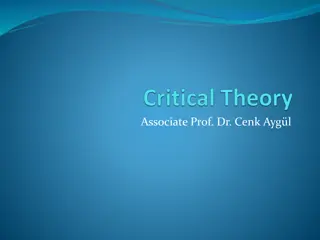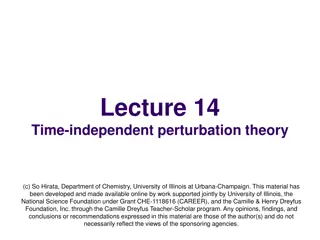Insights into Economic Growth Theories and Development Economics
Explore the perspectives of growth theory, foundational literature, general theories of economic progress, implications for institutions, modern development economics, and modern macro growth models with a focus on poverty traps. Delve into topics such as market division of labor, capital accumulation, entrepreneurship, private property, and the role of institutions in shaping economic development.
Download Presentation

Please find below an Image/Link to download the presentation.
The content on the website is provided AS IS for your information and personal use only. It may not be sold, licensed, or shared on other websites without obtaining consent from the author.If you encounter any issues during the download, it is possible that the publisher has removed the file from their server.
You are allowed to download the files provided on this website for personal or commercial use, subject to the condition that they are used lawfully. All files are the property of their respective owners.
The content on the website is provided AS IS for your information and personal use only. It may not be sold, licensed, or shared on other websites without obtaining consent from the author.
E N D
Presentation Transcript
Growth Theory: Two Views Mises University Auburn, Alabama
Recommended Literature Foundational: Menger, Bohm-Bawerk, Mises, and Rothbard Espinosa, Victor I. (2020) Epistemological Problems of Development Economics , Procesos de Mercado: Revista Europea de Econnom a Pol tica, XVII (1), 55 93. Holcombe, Randall. (2007) Entrepreneurship and Economic Progress Huerta de Soto, Jesus. (2006) Money, Bank Credit, and Economic Cycles, Chapter 5 _______. (2009) The Theory of Dynamic Efficiency. Shenoy, Sudha. (2007) Investment Chains through History or an Historian's Outline of Development, Using Goods of Ever Higher Orders , Indian Journal of Economics and Business, Special Issue, 185-215. _______. (2010) Towards a Theoretical Framework for British and International Economic History: Early Modern England. A Case Study.
General Theory of Economic Progress Product of Analysis and Synthesis Engines of Prosperity Market division of labor Capital accumulation Technology Entrepreneurship Economic progress is the happy consequence of a highly developed division of labor, taking advantage of an increasing capital stock embodying better technology, wisely invested by entrepreneurs.
Implications for Institutions Private Property Necessary for voluntary exchange Encourages capital investment Enables seeking of entrepreneurial profit Meaningful prices for economic calculation Sound Money
Modern Development Economics Culmination of historical process incorporating many factors: The Golden Age of Keynesianism (1948 73). The Marshall Plan National income statistics documenting economic inequalities Creation of international aid agengies (UN, IMF, and WB) Development of gap theory of the poverty trap
Modern Macro Growth Models and the Poverty Trap Harrod Domar Model Simple Keynesian Cross framework: Y = C + I Growth rate = savings rate/capital-to-output ratio depreciation Key Conclusion: positive relationship between rate of savings and investment and the rate of growth
Modern Macro Growth Models and the Poverty Trap Neoclassical Growth Model: Production constraint: Yt = AtF(Kt) Y = Output K = Capital A = Productivity shift factor: Often assumed to represent technology.
Modern Macro Growth Models and the Poverty Trap Diminishing Returns to Capital: Increased capital investment eventually will yield maximum output. Solow predicted there would be convergence between MDCs and LDCs.
Modern Macro Growth Models and the Poverty Trap Diminishing Returns to Capital: Continued economic expansion requires increased technology.
Modern Macro Growth Models and the Poverty Trap Endogenous Growth Model: Diminishing marginal returns to capital are offset by increases in technology The more we know, the easier it is to discover more knowledge The US had/has more people devoted to knowledge discovery process US developed Research Universities and Research Grants Source: David M. Gould & Roy J. Ruffin, What Determines Economic Growth?
Modern Growth Theory: Critique Poverty trap theory refuted by empirical evidence Modern growth theory is severely weakened by various forms of scientism: Model Building Mathematical Method Measurement Social Engineering
Modern Growth Theory: Critique Math Models: Good at describing equilibrium conditions; bad at describing dynamic economic order Take individual preferences as known and given Feature superficial consideration of time Economic problem becomes simple technical engineering constrained maximization problem
Modern Growth Theory: Critique Several weaknesses in the conception of key contributors to economic prosperity Leave out the market division of labor Focus on increasing inputs perceived as homogenous Poor at defining economic progress Poor at depicting entrepreneurship National Income Accounting contributes to bias of planning and focusing on inputs and growth of output rather than on economic progress























